|
Summary: The setting Sun became
a strange-looking crescent in central parts of the United States
on June 10, 2002, during a partial solar eclipse. [full
story]
Page
1 | Page
2 | This
is Page 3 | Page
4 | Page
5
Unless otherwise
stated, all images are copyrighted by the photographers.
|
|
Photographer, Location, Date |
Larger images |
Comments |
 |
Patty
Beasley, Corpus Christi, Texas, USA |
#1,
#2, #3 |
Photo details: Sony DSC-F707 digital camera. |
 |
Jimmy
Herrera and Lonnie Pacheco, Playa San Carlos, Jalisco, Mexico |
#1,
#2 |
In a small region of Mexico, the June 10th eclipse
was annular. Here the "ring of fire" sinks toward the
Pacific Ocean near the Mexican coast. Photo details: Olympus
OM-1; 500mm f/8
catadioptric telephoto lens. 1/60s exposures with 400 KODAK ULTRA
film." |
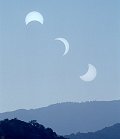 |
Thad V'Soske,
near Santa Isabel, California, USA |
#1 |
Thad used Kodak E100VS and an un-guided 400mm
Canon lens to capture this multi-exposure sequence of the eclipse. |
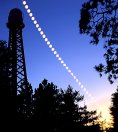 |
Dennis Mammana,
Mt. Wilson, CA, USA |
#1,
#2 |
D. Mammana: "I shot these images from Mt.
Wilson, north of Pasadena. The
sequence shows the eclipse over the 150-foot Solar Tower;
a 35mm lens was used and the sun was recorded at 5-minute intervals.
The crescents are projected
through a tree onto the exterior wall of the 60-inch telescope
dome." |
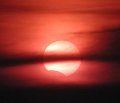 |
Jay Reynolds,
Schuele Planetarium in Bay Village, Ohio, USA |
#1 |
J. Reynolds: "We had about 25 people crowded
around for viewing, since there were so many clouds, most could
see the eclipse without any equipment. Most had never really
seen an eclipse so easily before." |
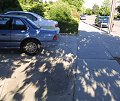 |
Brad Templeton,
the Silicon Valley, California, USA |
#1,
#2 |
Innumerable crescent suns are projected on cars
and pavement through the leaves of a magnolia tree. |
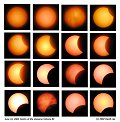 |
David Lee,
Victoria, BC, Canada |
#1 |
Photo details: Nikon Coolpix 950 using afocal
technique Telescope: Televue Pronto 480mm mounted on a Super
Polaris mount |
 |
Joan Barnett,
Goleta, CA, USA |
#1,
more |
J. Barnett: "[These are] crescent images
of the sun's light, filtered through my redwood trees, shining
on my fence. The branches and needles of the redwoods act like
many pinholes to create the images. The other shot shows the
image projected through one lens of some binoculars. The eclipse
was absolutely stunning!" |
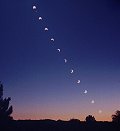 |
Joe
Orman, Phoenix, Arizona, USA. |
#1 |
J. Orman: "This multiple exposure was taken
on a single frame of film; it is not a composite and does not
digitally combine images in any way. Exposures every 10 minutes
show the sun progressing from uneclipsed, through maximum eclipse,
then back to uneclipsed just before it set. Then 40 minutes after
sunset, a final single exposure captured the twilight sky colors
and the planets Venus (upper) and Jupiter (lower)." |
 |
Will Galloway,
Cupertino, CA, USA |
#1,
#2 |
W. Galloway: "These are 2 images of sunlight
filtered through trees, creating crescent projections of the
eclipse on the ground. This is one of my favorite things to see
during an eclipse." |
 |
Richard
Wessling, Milford, Ohio, USA |
#1 |
R. Wessling: "The clouds made a very interesting
picture and acted as a nice filter." |
MORE IMAGES
- from Steve Sumner of
Colfax, CA: image
- from Will Galloway of
Cupertino, CA: image
- from Hana Haas of Huntington
Beach, CA: image. Haas
used a glass filter plate for welding from Home Depot in front
of the camera.
- from Mike Lynch of Kentucky:
image. The Sun was very
near the cloudy horizon.
- from Bart Santello of
Phoenix, Arizona: image.
"The image is a projection of the
eclipse onto paper from a simple hole-in-cardboard setup."
- from Brett Walker of
Chippewa Falls, WI: image.
- from Jon Smedley of El
Paso, Texas: image.
|












